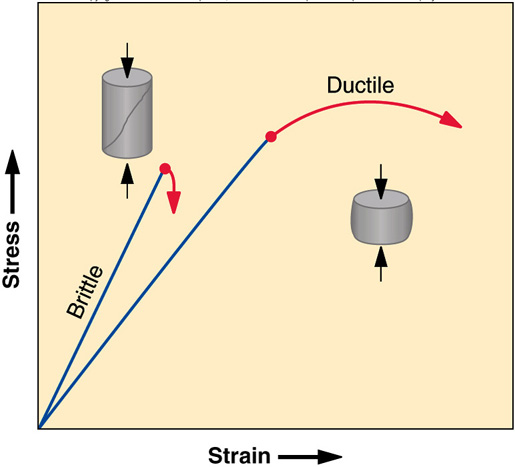CEEES/SC 10111-20111
Planet Earth
Structural
Geology Laboratory
Click here for a copy of the Lab
Manual Chapter
Deformation of rocks presents
itself on
the surface in the form of different structures. It is critical that we
understand how these extend into the subsurface.
A clear understanding of subsurface structures is
vital for an understanding of groundwater resources, pollution
migration, oil reserves, ore deposits, and the stability of road cuts,
bridge footings, and building foundations.
Deformation is caused by stress – a force
acting
on a body that tends to change its size or shape.
Stress = force per unit area, so the
magnitude of stress depends
not only on the
magnitude of the force, but also on the area to which it is applied.
 Compressive Stress
(compression) causes shortening.
Compressive Stress
(compression) causes shortening.
Tensional Stress (tension) causes
stretching.
Shear Stress cause one side of a
body to slide past the other (transform plate boundaries).
.
Strain = physical deformation that
occurs in response to stress.
Elastic Strain = temporary.
Plastic Strain = permanent.
Rupture = breaking of the rock
beyond strain limit.
Brittle
Deformation = rock breaks while undergoing elastic
strain.
Ductile Deformation = rock breaks
while undergoing plastic strain.
.
Pressure, temperature and rate of deformation determines brittle versus
ductile deformation.
.
Brittle deformation occurs commonly
at the surface of the earth (lower temperature) – ductile deformation
occurs at depth (higher temperatures). Folds form at depth.
Stress/Strain
conditions of common geologic
structures.
Recognizing and Describing Deformed Rocks
Describing Surface Orientation
Geologic Maps
The "Rule of Vs"
Geologic Cross Sections
Block Diagrams
Folds
Faults
 Compressive Stress
(compression) causes shortening.
Compressive Stress
(compression) causes shortening.